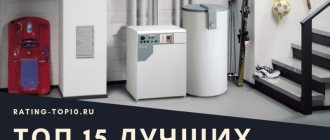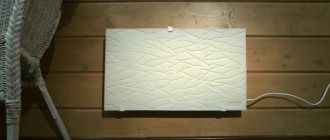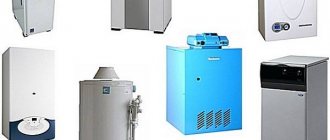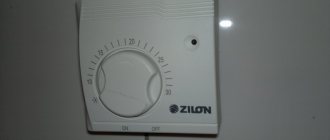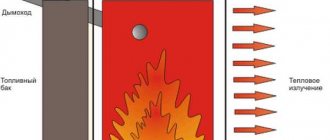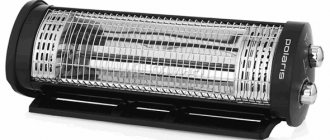What is better: convector or quartz heater?
Currently, convectors or quartz heaters are the most popular for owners of private houses and apartments. Recently they have become leaders, beating heaters and simple oil radiators due to their obsolescence. Convectors have successfully replaced heat fans and heat curtains due to their main positive properties: energy intensity, ergonomics, pleasant external design and high efficiency.
Convector or quartz heater - the best choice?
DELTA D-120
Even cheaper than a Centek brand device, you can purchase the DELTA D-120 model, designed to heat rooms up to 25 m2. It has 2 spirals of 400 W each: you can turn them on separately or together. Accordingly, in the second case, the power will be 800 W - even weak power networks in old country houses will be “powered”. It was included in the rating of quartz heaters due to its compact size, sufficient efficiency and decent build quality.
The device has a floor-standing design, that is, it is intended only for installation on a surface. It holds quite securely and is not so easy to drop. There is a convenient carrying handle at the top of the plastic case.
Choose: quartz or convection
Let's try to comprehensively understand the issue of choosing the best heater by comparing two types: quartz and convector.
The first convectors that were mounted on the wall appeared in Russia in the mid-90s. These models immediately showed high profitability and functionality; their first application was heating office premises, and then they migrated to ordinary people’s apartments. At the beginning of the 21st century in the Russian Federation, heaters were proposed for sale, which were a quartz plate with an internal heating element.
In fact, both types perform the same task, but due to some nuances for a specific situation, each has certain advantages.
Monolithic model: device and parameters
The second type of quartz heaters are monolithic products. Let's take a closer look at their design, operating principle and nuances of use.
Design and operating features
The quartz monolithic heater has a simple design and consists of the following elements:
- the main heating element is a spiral made of nichrome (an alloy of nickel and chromium, enriched with silicon, iron, aluminum and manganese), which has an impressive resistivity, an increased level of heat resistance, good ductility, durability and reliability;
- monolithic slab - a heavy (about 12 kg) rectangular fragment made of quartz sand.
When assembling the unit, the nichrome spiral is equipped with the appropriate connecting parts and fasteners, and then placed in a zigzag shape in a mold and filled with a liquid solution of quartz sand.
Then the workpiece is placed under a press, given the desired shape, thoroughly dried and subjected to intensive high-temperature treatment in an oven. The finished product has clear parameters of length and width (60*35 cm), and the thickness of the slab is 2.5-3 cm.
A monolithic quartz heater is a stationary device and does not require constant transfer to different rooms. Manufacturers equip their models with special durable brackets for convenient mounting of the unit on the wall
The equipment turns out to be absolutely fireproof, since the heating element is located inside the quartz plate and has no contact with the external environment. The area where the power cable is attached is also completely covered.
This design feature eliminates the heating coil from breaking and reduces to zero the risk of a short circuit in the system.
The durable nickel-chromium alloy from which the heating element is made allows the device to heat up to 100 degrees and reduces the chance of the coil burning out to a minimum. This extends the life of the device and makes it more reliable
Almost all modern models of monolithic heaters have a special coating that provides the device with a high level of moisture protection. This quality allows you to install equipment not only in living rooms, but also in the bathroom or kitchen.
Quartz sand quickly accumulates thermal energy, and then releases it into the room for a long time in the form of infrared radiation. Even after disconnecting from the power supply, the device continues to emit useful heat and warm up the room for about an hour.
For all their bright advantages, monoliths also have disadvantages.
Disadvantage No. 1 . The weight of some models reaches 13 kg, and this significantly limits the range of places where the unit can be installed.
Thin interior partitions or false walls made of plasterboard simply will not withstand the load and will crack, forcing owners to spend additional money on cosmetic repairs.
Disadvantage No. 2 . During operation, the surface of the monolithic slab heats up to +80…+120°C. If you touch it carelessly, you can harm yourself and get seriously burned.
In places where families with small children or pets live, the installation of such equipment is unacceptable without a special protective screen, which will make the fire stove inaccessible without in any way affecting the level of efficiency of the device itself.
Disadvantage number 3 . The lack of remote control also creates certain problems. But most of the devices do not even have an on/off button, and they are directly connected to the outlet using a regular power cable with a plug at the end.
Some manufacturers still display a toggle switch on the external panel to activate the equipment, and in addition offer customers the opportunity to purchase a thermostat with a regulator that allows them to control the heating level and use electrical energy more economically.
Alternatively, you can connect the heater through an outlet with a thermostat.
Technical parameters of monoliths
A standard monolithic heating device has a size of 61*34*2.5 cm and weighs about 10 kg. Heating begins immediately after plugging the cable into the outlet. After 20 minutes, the stove reaches maximum operating temperatures (about +90°C) and fills the room with comfortable warmth. The rated power of the unit is 0.5 kW.
A high-quality monolithic heater holds its shape perfectly and does not crack during operation. If the slab has peeled off and lost its integrity, it means that it is a fake and in its manufacture they used not purified quartz sand, but gypsum, whitewash, marble chips or cement
To heat a 16-meter room with a normal ceiling height, one monolithic module is enough. The equipment comes with three brackets (two lower and one upper). With their help, you can quickly and securely mount the device on the wall and immediately begin to operate it in full mode.
The thermostat allows you to avoid freezing in winter, but at the same time use electricity economically. Sometimes it comes included with the equipment initially, or you can buy it in a specialized store and install it at home yourself
If a large room or an entire house/apartment needs high-quality heating, a one-piece heating system is created from several monoliths with a parallel connection of each device into a common complex.
Such equipment is controlled automatically using temperature control devices.
Functionality: which is better?
First of all, in order to correctly select a convector or quartz heater, you need to understand the technical parameters and functionality. We will track them down specifically and point by point.
Convector - heating the flow air
Convectors, in principle, use the movement of heated air to operate. The very physics of air is that when heated, it begins to circulate, warming up the entire room. The convector steadily heats a mass of air, it goes up, and its place is taken by the next volume, and this process is continuous. The air is heated successively in layers, and the room is saturated with warm air mass. Electrical energy is converted into thermal energy.
But there is one characteristic nuance: warm air rushes upward - this is a physical law of thermodynamics, so warming up the comfortable zone where a person is located will take a somewhat long time. Until all the air in the room passes through the convector. Often weak convectors are not able to warm up the mass of air, and the floors remain cold, while the top heats up. This leads to headaches due to lack of oxygen, which burns out.
In this case, the air temperature in the upper part will always be higher than in the lower part. But when the convector is constantly turned on, the entire area of the room is uniformly heated to the temperature you set.
Prices for quartz heaters
In stores you can find a variety of prices for quartz heaters. It all depends on the brand, heat-generating apparatus, design and additional equipment.
For example, an infrared unit K-19N for heating 10 sq.m. can be bought in Krasnodar for 1,500 - 2,500 rubles. In this case, the power of the device will be equal to 2 kW. But a monolithic quartz panel of the Texture brand with a power of 0.4 kW, designed for the same area, can be purchased for 2,300 - 5,000 rubles. However, if we compare heaters with the same power, they will be in approximately the same price range.
Most Russian consumers prefer monolithic quartz devices, which weigh 10-12 kg. The fact is that the heating method used in them has common features with the good old Russian stove. So people on a subconscious level feel that such devices will bring them more warmth and comfort.
In Krasnodar, the price of monolithic quartz heaters (without a thermostat) is in the range of 2,000-2,500 rubles.
However, infrared devices are, from a scientific point of view, much more productive. At the same time, they are smaller in weight and volume.
Quartz local heating heater
These heaters use a completely different operating principle and are designed somewhat differently. By design, they are a quartz slab with the addition of clay ceramics. A groove is made in the plate for the heating element; it is most often made of an alloy of nickel and chromium - nichrome carbide. This alloy has excellent heat resistance properties, which means heat transfer increases. The electrical energy of the 220 V network is converted into heat on the heat exchange element. And the heat is transferred to the quartz slab. The heating temperature reaches 95 °C.
The obvious superiority of a quartz heater.
First of all, heating from the device occurs locally. The heated stove begins to release heat into the atmosphere, gradually increasing the air temperature in the room. At the same time, energy consumption costs are minimal, since the quartz slab has a long cooling time.
There are also infrared-type quartz heaters, such as “ ThermoQuartz. ” Their design is slightly modified: the typical model uses yellow opaque quartz, and the quartz-infrared model uses ceramics with the addition of the same quartz. This design first reflects heat inside the heater, and after it accumulates, it begins to radiate it. The infrared spectrum heats the air and objects in the room, which then release energy into the space of the room. The uniqueness of these devices is the combination of both heating properties, convection and infrared.
With local heating, one positive nuance stands out: very high efficiency and the absence of extraneous energy costs for heating large masses of air, if the room is large. But these aspects do not provide a complete answer to the question of which is better: a convector or a quartz heater.
Quartz heater for home: types of device
The definition of “quartz heater” includes two types of devices:
- Infrared devices.
They have some similarities with “Ilyich bulbs”, since they are a tubular element placed in a quartz glass housing. Inside the structure is a twisted tungsten/carbon/nichrome filament.
- Monolithic panels.
These are solid quartz sand slabs. There is a heating element inside the device.
In both designs, the operating principle is based on infrared radiation. The only differences between them are the wavelength and heating efficiency.
We also add that an infrared heater emits radiation that heats objects in the room. And in a monolithic device, the heating element heats the plate to 90 degrees and turns it into a powerful IR emitter. The airflow convention then distributes the heat.
Both devices belong to the energy-saving group, but each of them consumes a different amount of electricity. Quartz heaters come in wall and ceiling types. Under certain conditions, the efficiency of the units depends on the installation method.
Infrared quartz heater: pros and cons
Infrared heaters are much more productive than convection heaters. They have a directional effect that works the same way as the sun's rays. Objects and people exposed to radiation begin to immediately feel warm. And when heated, they transfer heat to the atmosphere. Thus, people do not waste electricity “in emptiness”, only on heating the air. In addition, heat is concentrated not under the ceiling, as with convection, but near the floor, since infrared radiation hits it.
Infrared quartz heaters are good for the following reasons:
- silent operation;
- a light weight;
- The device is easy to install;
- environmental friendliness;
- inertia;
- the presence of a thermostat and the possibility of remote control;
- you can direct radiation to heat a certain part of the room;
- good value for money.
The units have only one drawback - a bright glow.
On the one hand, it can be used instead of a lamp. But on the other hand, such light will definitely not let you sleep. Therefore, for the night you need to either buy another heating device, or put up with the cold in the morning.
Monolithic quartz heater: pros and cons
A monolithic heater looks like a flat rectangular panel no more than 25-30 mm thick. The heater can be wall-mounted or floor-mounted.
Closed monolithic devices combine the convention and infrared operating principle. When heated, the stove becomes a source of infrared radiation. At the same time, due to its dimensions, it carries out active convective heat exchange with the surrounding air.
Among the advantages of the product:
- The surface of the slab can be repainted (usually the manufacturer informs about this possibility in the instructions).
- The device lasts a long time because the heating element is isolated from the external environment.
- Quartz heaters for home are energy saving.
- Most models are equipped with a temperature sensor.
- The risk of fire is minimal.
- Since the heating element is insulated, the device is suitable for any room.
- If the unit falls and the heating element depressurizes, toxic substances will not enter the air.
Monolithic home heaters can warm up to maximum temperature in 20 minutes. And after switching off, they retain heat for 1.5 hours.
Disadvantages of monolithic quartz heaters for home:
- they are heavy (some weigh 13 kg), so they are difficult to move;
- difficult to install due to weight (plasterboard walls will not withstand the load);
- the surface of the product warms up to 80-120 degrees, and you can get burned on it;
- If there are children and/or animals in the house, then it is worth purchasing an additional protective screen for the panel.
Power of quartz heaters: which are the most economical?
Ordinary devices with water/oil coolant consume approximately 0.8-2 kW. But quartz heaters spend noticeably less “precious” electricity. During operation, they consume 0.4-0.6 kW, heating 12-18 sq.m. Thus, those who want to save on energy costs should buy a quartz heater. In the market of electric heating devices, they are the undisputed leaders in energy saving.
Those who are looking for the most economical models among various manufacturers of quartz units should know one fact: almost all products consume electricity the same. They spend approximately 400-600 square meters, while achieving an efficiency of 99% (literally all the energy consumed is converted into heat). So, for example, you can buy a TEPLEKO quartz heater with dimensions (w/h/t) of 600/350/25 mm. with a power of 0.4 kW. In this case, the heating time of the radiating surface to 75 degrees is no more than 20 minutes.
A heating element
The element that converts the energy of electric current into heat is usually called heating. Its function is known, but a few words should be mentioned and compared about the device.
The convector heater is a stainless steel rod into which a vanadium or tungsten spiral is rigidly installed. There is a layer of air between the inner surface of the rod and the spiral. This layer heats up and serves as a “heat exchange medium” for transferring energy into space. Due to the fact that the rod is in direct contact with the atmosphere, ringing may occur when heating or a malfunction of the heater occurs. It is also dangerous from a fire safety point of view.
The principle of the Quartz heater
The quartz heater heater is technically the same device, but only a nichrome spiral is installed directly into the cavity of the quartz slab, also with an air layer. Breakdowns or burnout of the heater do not cause any dangerous factors; it simply stops working.
Heating costs
Heating costs
It should be noted that they are also influenced by the development of innovative technologies. Currently, both electric convectors and quartz heaters can be equipped with various automation and electronic control devices. These devices can enable devices to be turned on for short periods of time while saving electricity, as well as setting a variety of temperatures using air heating sensors.
These measures practically equalize the two devices in terms of efficiency, but if you calculate the efficiency and costs for “classic” models of convectors and quartz heaters, then the positive effect will be in favor of the latter device.
The costs of heating the room for both models are the total sum of the factors of electrical energy consumption and heat transfer into the space. If the ratio is equal, then such a product will not be profitable.
Monolithic quartz heater: characteristics
Such a monolithic air heater in a wooden house or country house consists of modules connected in parallel. The basic equipment also includes equipment for regulating air temperature.
Such heaters can be installed both on the floor and on the wall, and they are completely fireproof. Now let's look at all the pros and cons of this type of heating apparatus. As for the negative properties, we can safely say that no disadvantages were noticed in this electric heating device, even after numerous diverse checks and experiments.
Pros:
- High heat capacity.
- Manufacturers guarantee that the electrical heating device will last a long time, and all this time it will reliably heat the house.
- Since the principle of operation is based on a simple scheme, which consists in the direct conversion of electrical energy into heat, there is no doubt that exactly as much electricity will be spent as is needed to heat the room.
- According to experts, one average monolithic quartz heater can easily heat a room whose volume does not exceed 15-16 m3.
- A unique alloy using quartz sand allows the device to radiate heat for a long time even after being disconnected from the network.
- Safety in use is explained by the fact that quartz monolithic heaters cannot heat above 90-95 ᵒC;
A special case of monolithic heating devices is a quartz battery, which also has numerous positive reviews from both specialists and the general population.
Design and external attributes
The appearance of a convector or quartz heater can be similar, they can suit almost any interior. Most often they are mounted on the wall using special fasteners. The convector, since it uses heating of the internal spiral and light fans, can produce extraneous noise.
Quartz heating products have a standard size and are similarly mounted on the wall. Their color scheme and shape are always the same, so you should think about the design. Completely silent in operation.
It is necessary to think very specifically about the issue of integration into the design.
Where can quartz heaters be mounted?
According to the method of mounting, wall and floor heaters are distinguished. In the first case, the unit is mounted using brackets and fittings for fastening. The product can be hung directly from the ceiling. In the second case, the kit includes a movable floor stand.
If a monolithic floor heater is placed too close to the floor, this will impede the air flow (after all, it heats according to the convection principle). Therefore, you should leave a distance of approximately 20 cm between the floor and the device.
Choice of modification
The heater market is currently oversaturated with many modifications. There are characteristic ones that will be listed below for both types.
Convector
Modifications of technical parameters and device:
- Dimensions and installation options. Convectors, in addition to wall-mounted, can be floor-mounted or built-in. Floor-standing ones are simply installed and fastened to the floor, while built-in ones are integrated into a special hidden niche with a ventilation grille.
- Convectors are continuous or direct-acting. Their difference is that in-line fans are installed to accelerate heating of the room.
- Varied design. In shape, such systems are elongated rectangles with a heating element, but a variety of shapes are possible.
Quartz heaters
- Product sizes are standard 64x24x2.5. But variations and custom-made heaters are possible.
- The design involves the use of yellow quartz in the formation of the slab. But it is possible to use transparent quartz glass.
The choice is made based on personal preferences and requirements for the functionality of the product.
Distinctive features of a quartz heater compared to convection:
- positive economic effect;
- huge thermal capacity;
- an alloy of chromium and nickel (nichrome) is characterized by great durability;
- application of an innovation called the “heated brick effect”. Studying this effect, the developers came to the conclusion that the use of a quartz slab makes it possible to most effectively convert the energy of electric current into heat;
- After calculating the efficiency, it was found that one stove of standard overall dimensions can heat an area of 15 square meters of room space. m;
- It is possible to use various types of automation and electronic control systems. Connecting temperature and humidity sensors allows you to organize the operation of the heating system, adjusting to changing climatic conditions in the room;
- have proven themselves perfectly in use for country houses and dachas. At the same time, the use of automatic regulators allows you to maintain the heat temperature even after leaving the dacha, for example, 10–15 °C. The use of the device in dryers and garages is similar;
- during operation they do not burn oxygen in the room. This can lead to headaches. In the old days, containers with water were placed next to oil radiators for such cases, so that the heat would burn out the water, saving oxygen in the room. There have been cases when people “got crazy” and ruined their health.
These characteristics are typical and can be used as a kind of reminder when choosing heating devices of this type or similar ones. The choice should be approached with the utmost care, since choosing a heater is a matter of creating coziness and comfortable living in an apartment or house.
The best lamp heater for the home
The Ballu BIH-L quartz heater is the best device in its line. It is suitable not only for home but also for outdoor spaces. The model belongs to the energy-saving heaters for the home.
Thanks to special fins, the device evenly heats a perimeter up to 20 sq.m. To maintain a comfortable temperature and protect against overheating, the heater has a built-in thermostat.
The Ballu heater can be mounted both on the wall and on the floor. The kit includes special screws for wall installation. A tripod may need to be purchased separately.
Pros of the Ballu heater:
- wide radiation range;
- the product does not burn oxygen;
- silent operation;
- the housing is protected from moisture;
- optimal price.
The disadvantage of the Ballu heater is that it does not have power adjustment. Only the power button. In addition, like all other similar models, the heater glows brightly.
We also recommend paying attention to such models of infrared heaters as: Timberk TIR HP1 1800, Almac IK11, PECAHTA IKO-2000, SUPRA QH-817.
If you live in Krasnodar, you can buy a Ballu infrared heater with home delivery in the online store Valles.ru. In addition, we deliver heaters to Simferopol, Sevastopol, as well as other cities, since we have fast delivery throughout Russia.
Choice for home: convector or quartz?
If you need to heat a large room evenly, it is better to buy a quartz heater. Since a large area will be heated unevenly by the convector. In addition, quartz heaters can be installed directly in the comfort zone, and they will not disturb it, while convectors, driving air around the room, can cause discomfort.
If we assume that a convector or a quartz heater is better in terms of saving money on paying electricity bills, then a quartz heater again makes the most sense. The positive effect is due to long-term cooling, maximum heat transfer to the space, as well as low energy consumption directly during operation. These measures practically equalize the two devices in terms of efficiency, but if you calculate the efficiency and costs for “classic” models of convectors and quartz heaters, then the positive effect will be in favor of the latter devices. Quartz heaters generally win in a number of parameters that were indicated above. Therefore, your choice must be based on this fact.
A convector with a thermal curtain mode, when the air is directed downward, benefits only at one point in the living space. At the entrance, if there are drafts. The thermal curtain will pick up the cold air of the draft, warm it up and reduce the negative effect to nothing. Such heaters are very often installed in a variety of industrial premises and sites, workshops.
Convectors can also be installed to provide the “warm floor” option, when the air is heated literally from 5 centimeters above the floor level. This option has a positive effect when used in private apartments, especially in regions with cold climates. In this case, the heat will similarly spread through convection throughout the room.
So, answering the question - what is better, a convector or a quartz heater, the best option would be a combination of these two properties. These are ThermoQuartz panels.
Bagan REN-4
The compact household heater Bagan REN-4 is made in the form of a decorative wood panel measuring 40 x 60 cm. At a price of 1,450 rubles, the power of the device is 250 W. Therefore, it will be possible to provide heat only to small rooms or individual zones with an area of 4-6 m2. If used in a spacious room, additional heating will be required.
Heating of the surface is provided not by a filament, as in most monolithic devices, but by a distributed electric heater. Its differences are high heat transfer and long (up to 25 years) service life.
In addition, due to the use of REN, the device is safe for use in residential premises and does not dry out the air. Other advantages, in addition to the attractive design, include the included wall mounting and relatively close heating. The disadvantages include a short cord - this feature will have to be taken into account when placing the equipment.
Comparison of infrared and quartz heaters
Thus, based on the above operating principles, these two types of heaters can be compared.
| PARAMETER | INFRARED HEATER | QUARTZ HEATER |
| ENERGY EFFICIENCY | 0.95 | 0.98 |
| TEMPERATURE OF THE EXTERNAL SURFACE OF THE CASE OR HEATING ELEMENT | 50-60 DEGREES | 90-95 DEGREES |
| CONTACT HAZARD WITH BARE HANDS | ABSENT | YOU CAN GET A BURN |
| STRENGTH | DAMAGED BY MECHANICAL IMPACTS | DO NOT DAMAGE AND SURVIVE FALLS FROM GREAT HEIGHTS |
| WEIGHT | 2-3 KILOGRAMS DEPENDING ON SIZE | FROM 8-10 KILOGRAMS DEPENDING ON SIZE, REQUIRED ATTACHMENT |
| FIRE SAFETY | NOT RECOMMENDED FOR USE NEAR FLAMMABLE OR EXPLOSIVE OBJECTS, REGULARLY WIPE AWAY FROM DUST WHICH MAY CAN IGNITE | HIGH. NOT RECOMMENDED FOR USE NEAR OBJECTS THAT WILL FIRE OR EXPLODE AT TEMPERATURES AROUND 80 DEGREES |
| REQUIREMENTS FOR THE MOUNTING PLACE (WALL OR CEILING) | NO | THE WALL MUST BE STRONG TO EASILY WITHSTAND 10 KG LOAD; IT IS NOT ADVISABLE TO HANG A QUARTZ PLATE OVER THE WALLPAPER |
| AUTOMATIC SHUTDOWN SUPPORT | THERE IS NO SENSE TO EQUIPPING WITH AUTOMATION, SINCE IT WILL REDUCE EFFICIENCY | FULL. THERMOSTATS OR OWN SMART HOME SYSTEMS, INCLUDING SCHEDULES (BUT REQUIRED EQUIPMENT AND SKILLS TO SET IT UP) ARE SUPPORTED |
| EFFICIENCY IN OPEN AND SEMI-OPEN AREA | HIGH IF THERE IS NO DIRECT WIND. BUT IF IT IS, THE FURNITURE AND THE REST WILL BE PLEASANT TO THE TOUCH. CLOTHING ALSO HEATS UP ON A PERSON | LOW. CONVECTION FLOWS “REMOVE” HEAT FROM THE SURFACE OF THE HEATING ELEMENT |
Thus, it cannot be said that one type of heater is better than another in all respects. But in some situations, infrared is superior to quartz - and vice versa.
The best quartz heater over the door
Noirot Royat 2 1200 is quite expensive, but this is justified by its excellent economy and operating efficiency. The device begins to heat immediately after it is turned on; it has a reliable wall mount.
There is a rotation angle of 30. A very high-quality device with a moisture protection function.
Pros:
- Moisture protection.
- Three levels of power adjustment.
- Reliability.
- Absolute noiselessness (the bird will not be frightened by extraneous sounds).
- Special wall mounting.
- Simple mechanical control.
Cons: The only disadvantage we can highlight is the high price of the device.
Best quartz heater with sand
The TeploPlit quartz heater is made of environmentally friendly materials: quartz sand, ground marble and white clay. It works on the principle of a cooling brick.
The heating element is completely insulated within the structure, which only enhances its safety, durability and heating efficiency.
The device is designed for long-term operation; it can not be turned off for a long time. There is no way it can overheat, as the heater manufacturers claim.
The devices are available in a white plate version, which can be easily repainted to the desired color. It does not have sharp corners or edges, does not heat up too much and is therefore completely safe; it can be safely installed in a child’s room.
Pros:
- Attractive appearance.
- Highly efficient work.
- The heating area is 8 m2.
- Complete safety of the device.
- Silence.
- Compactness.
- Low price.
Minuses:
- Not a very strong monolithic panel, prone to cracking.
- Small heating area.
The best quartz heater with thermostat
Stiebel Eltron IW 180 can store radiant heat. It works for some time, and then releases the accumulated energy into the space of an apartment or house for a long time. This makes the device highly efficient and economical.
It can also be rotated at an angle of up to 40. And the housing with enhanced moisture protection is indispensable in damp rooms and when it rains outside.
This is an environmentally friendly heating device. During operation, it does not make the slightest noise, there are no air movements, and there is no burning smell.
Radiation of heat only leads to heating of objects caught in its zone. Therefore, it is possible to heat local areas in open areas even in the presence of wind. In half a minute the required power is achieved.
Pros:
- Large area of heated room.
- Moisture-proof housing.
- High heating efficiency.
- Normal price.
Minuses:
- Not very convenient to mount to the wall.
Best Ceiling Quartz Heater
The MO-EL Sharklite 718 quartz ceiling heater is distinguished by increased operational reliability. It has a special housing and a special lamp mount, so it can withstand an energy shock of 2 J.
It is also protected by manufacturers according to IP55 class. This gives it water and dust protection.
The device has an elegant and bright design. In addition, it heats the space very effectively.
The device uses a ruby infrared lamp, which gives a soft and unobtrusive light, thanks to which the model not only produces the much-needed heat, but also creates a cozy lamp atmosphere.
The device has performed well in cafes, country houses, verandas, clubs, offices, and shops. The device can be installed both indoors and outdoors.
Its power is enough for an area of 10 m2. The Sharklite series, to which this unit belongs, is distinguished by its durability, resistance to shock and ultraviolet rays.
It combines advanced technology and stylish design. The models are very easy to mount on the ceiling and use.
Pros:
- Using a heater, you can quickly organize comfortable heating.
- Sufficient operating area of the model (up to 10 m2).
- Ergonomic Italian design.
- Impact protection.
- Simple and easy to use.
- Easy to install.
- Manufactured in the European Union.
- Can be installed both indoors and outdoors.
- One halogen lamp has a service life of up to 5 thousand hours.
- Instant heating.
- Uniform heat distribution.
- No sounds.
- Various installation methods (on the wall, on the ceiling, on the floor).
Minuses:
- High price.
Best Wall Mounted Quartz Heater
NeoClima SHAFT-2.0 will perfectly heat a room of 20 square meters. Using special brackets, you can install it on the wall, and a tripod will help you place it on the floor.
The model has an ergonomic design and standard parameters that allow it to be used in different rooms. The degree of protection of the device is very high.
The Neoclima SHAFT-2.0 quartz heater is economical in terms of electrical energy costs, allowing you to save up to 50 percent of the cost of operating its electric counterparts.
In addition, the quartz heating element is environmentally friendly.
A good wall heater that instantly raises the temperature in a fairly large space and replaces two convectors of similar power. The steel case is super reliable, the device is worth the money spent on it.
Pros:
- Fast heating with not very high energy consumption.
- Doesn't burn air.
- Does not burn dust, there is no burning smell.
- Silence.
- High efficiency, reliability and durability.
Minuses
- High price.
